Baby Boomer Nostalgia Galore – 50s American Cars in Cuba
Category: Baby Boomer Retirement Issues
December 21, 2014 — Welcome back to the 50’s! Your editor had the good fortune to visit Cuba this November, only a few weeks before news of the normalization of relations was announced by the President. We found Cuba to be a fascinating country of many contradictions. Our visit was educational (we went with the Florida TREE Institute) and extremely interesting.
One of the definite highlights of the trip was the chance to be surrounded by, and even ride in, countless cars of our baby boomer youth. We’d like to share this nostalgia through some musings and photos. As an interactive exercise, we’d like to enlist your help in identifying some cars that defy our cataloging skills. At the end of this article we will share a few brief observations about Cuba, if you care to read on.
Those glorious American cars of the 50s
This might be a guy thing, but when your editor was growing up in the 1950s cars were a significant obsession. When the new models came out in September or October every year, my young friends and I would haunt the dealerships, admiring these gleaming vehicles and comparing notes about styling changes. 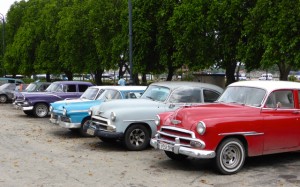
When a car rolled by on the street, we would compete for who could identify first. By our early teens, we were experts; although just about anyone could differentiate the soaring tailfins of a ’57 Chevy from the horizontally rolled over ones of the 1958 model, identifying models from other years was more of a challenge. (See our Pinterest board for pictures of more than 40 American classic cars in Cuba).
In those days the Big 3 made radical styling changes in the odd years, and usually tinkered with minor trim elements in the even years. All of the nameplates within a company in the Big 3 basically had the same sheet metal for several years in a row. Only the corners of the cars, their grills, and the trim differentiated, for example, a DeSoto from a Plymouth or Chrysler, or a Buick from an Oldsmobile or a Cadillac. Adding to the complexity, though, were the different models within each nameplate, which got more exotic
as the 50s rolled on. Chevy started out with the One Fifty, Two-Ten, went on to the BelAir, and in 1958 added on the top of the line Impala. In the 50s Cadillac started replacing stodgy model names like the Series 6 and 62 with much more exotic ones: Coupe de Ville, Fleetwood, Biarritz, and Eldorado. 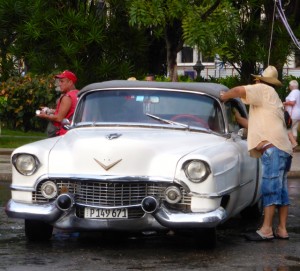
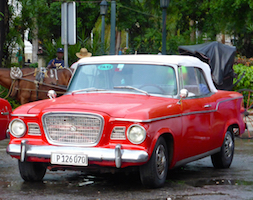
Within each nameplate there were optional engines and body models (4 door vs. coupe vs. wagon, vs. hardtop) that led to a mind-boggling variation. By comparison, today’s one model fits all approach seems downright boring. Keeping track of all these different cars was a good task for our otherwise unfocussed young minds. But when it came to knowing the ins and outs of the minor car manufacturers that still existed in the 50s we were less expert: the subtleties of Packards, Hudsons, Studebakers, Nash’s, and Ramblers eluded us. 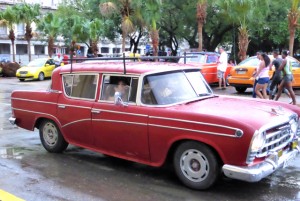
Which Leads us to Havana
We haven’t seen any official estimates, but our back of the envelope guess would be that about 50% of the automobiles on the road in Cuba in 2014 were American cars from the late 40s to 1959. The rest of automobiles we saw were Russian Ladas, French Puegeots or Citroens, Fiats, or cheap models of Japanese and Korean cars. By far the American cars were the most distinctive, and for the most part, in great shape.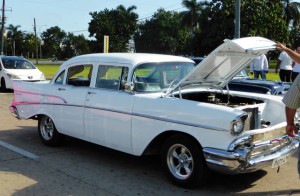
The dominance of American cars on the streets of Havana is rolling proof that Cuba was an American satellite in those days. They also give a clear rendering of the styling transition that American manufacturers went through in the 50s. In the first half of the decade cars took a decidedly more modern turn as fenders, hoods, and trunks blended into a whole styling package, instead of being separate boxes. Starting in ’56 the Big 3 took a cue from Cadillac and began amping up tail fins to sell cars. GM and Chrysler took it to extremes in 1957. Although the 1958 GM cars stepped back from that trend, tailfins shot up again in 1959, reaching their apex with that year’s Cadillac. 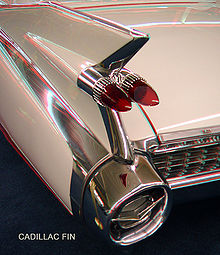
Ford exercised some restraint on that trend, which might have cost them some sales.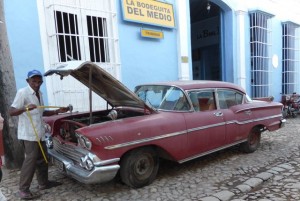
The stop year was 1959 – the year the Cuban Revolution was over. The troubles with the USA began, and no more American iron came in the country.
How can they still be running?
One of the first questions the visiting American has about all these beautiful antiques is, how could they possibly still be running after all these years? 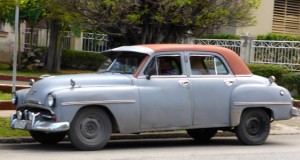
Particularly when we remember that the average car of the 50’s was a risky proposition after 5 years, and probably rotting in a junkyard after 10 years and 100,000 miles. And with an American embargo on spare parts, how do you replace a carburetor on a ’54 Chevy? The main answer is that after the Revolution people who weren’t rich got to keep their property. A car became a significant asset, probably the biggest one you had. And, you would never have the money to replace it. So preservation became a priority, and great ingenuity has been put forward to keep these cars running. 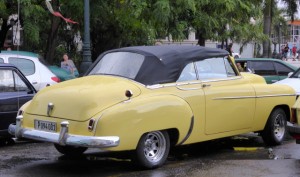
Will these cars be for sale?
Another big question that has come up since the thaw in Cuban-American relations is, what will happen to all these cars? Some people assume they will all be snapped up by eager American collectors. 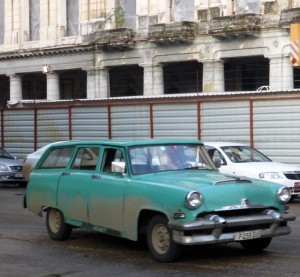
Others, like your editor, assume that the Cuban government is going to protect what amounts to an open air museum of vintage American cars. After all, the cars are a very big tourist draw, selling them would be killing the golden goose. Of course that is not a completely simple issue. These old clunkers probably average around 10 m.p.g around town, so they are expensive to operate. And many Cubans wouldn’t mind getting a load of dollars for one. So who knows what will ultimately happen?
Part 2: Observations about Cuba today
The country is one big contradiction after another. The Cubans are very proud of their country and the revolution coming to power in 1959. The governments of the U.S. and Cuba have been at odds ever since, but the people seem to genuinely love the American people and yearn for greater ties. One of the greatest ironies is the subject of this article – the American cars of the 50s. Cuba has blamed the U.S. for all of its problems for the last 50 years, yet the country rides around in American cars that are greatly revered.
Nobody, or almost no one, in Cuba goes hungry. Every family gets a highly subsidized ration card which lets them buy large quantities of rice, cooking oil, and other basic supplies at extremely low prices. Everyone has access to good quality health care, at no cost. Likewise everyone in the country can get a free education, even up to the highest levels. Housing is subsidized or free if you own. On the other hand, this socialism is costly. The country’s economy is a shambles, with imports greatly exceeding exports. There is very little technology and the country is falling behind the rest of the world in almost every area. Cuba has almost nothing to export beyond rum and cigars; its highest economic asset is undoubtedly tourism.
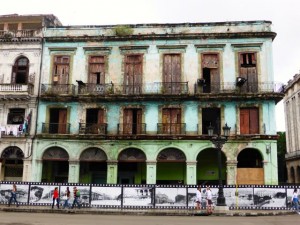
The people aren’t starving, but very few of them have any of the possessions Americans take for granted. No Cuban on a government salary could possibly afford to eat at any tourist restaurant of stay at a hotel. Almost everyone is an employee of the government, and the pay is usually about $20 a month. With those low wages teachers, engineers, and other professionals would rather work in the booming tourist industry, where free-tipping foreigners make bellboys and waiters some of the highest paid people in the country. Capitalism is evolving and growing, with countless entrepreneurs opening restaurants, stores, and providing services. The government tolerates capitalism, and is happy to tax those who can get approval to practice it. Meanwhile petty crime and corruption are rampant, as people do what they can to make their standard of living less desperate.
Political freedom is a huge problem in Cuba, The government controls the press and you could easily end up in jail if you criticize it publicly. The Communist Party decides what schools you will go to and what you will do for a living. The impression we got is that most people are much more interested in increasing their standard of living than they are in changing the regime. Hence the great eagerness to see the USA eliminate our trade embargo, which most Cubans are confident will result in an avalanche of U.S. greenbacks. Who knows in what direction the government will go. If it remains too controlling, not much will change. Yet it is undoubtedly too proud to step too far away from the revolutionary dogma of the last 50 years.
Comments? We want to hear your stories about your love affair with old American cars! And particularly, can any sharp-eyed car buffs straighten us out about the year, make, and models of the cars we’ve included above?
For further viewing – see the Topretirements Pinterest board of Old American Cars in Cuba – over 40 pictures.
President announces normalization of relations with Cuba
Comparison photos provided by members in response to our challenge:
Michael brought up a good point – with only 1 photo and not always from the best angle it is hard to positively identify these cars. They have also been modified over the years. Nevertheless he provided these photos to compare against the ones in this article we couldn’t identify – thanks Michael!
The photo of a 1952 Dodge Coronet to compare against our “Dodge 1”. Looks pretty similar
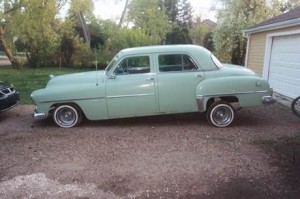
He also provided this photo of a 1953 show Cadillac, which sure looks like Caddy1
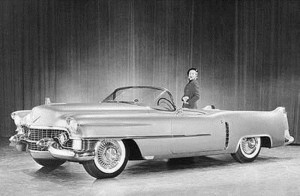
Here is a photo of the best fit for Studebaker 1, a ’59 Studebaker Lark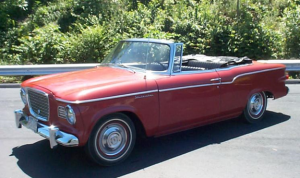
Best fit for Rambler 1 – This 1957 Nash Rambler
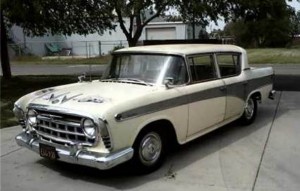
Mercury1 – The model shown here is a very fancy 1954 Mercury Monterey. There are significant differences, things might have been added and subtracted on the 2 models.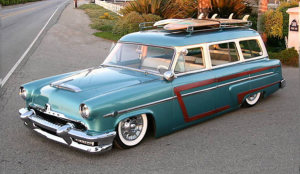
Lastly, here is the car that Michael thinks is the model for “Yellow1” – unidentified: A 1950 Chevrolet Styleline (see his comment for more commentary)
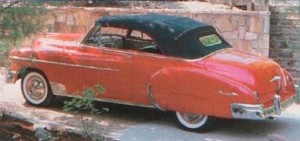

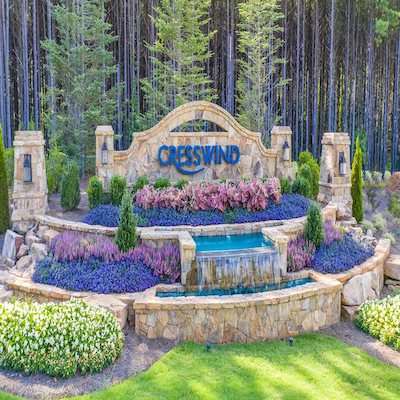
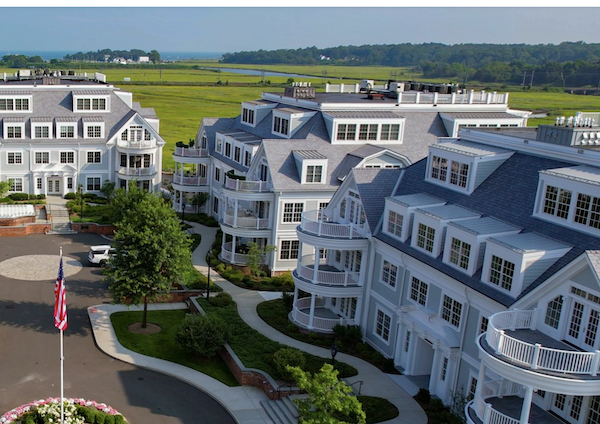



Comments on "Baby Boomer Nostalgia Galore – 50s American Cars in Cuba"
Caps says:
This article prompted some bemusement and joy, as I recall how the boys at school talked on and on about exactly what was mentioned here. Late hubby was just that sort of gear head, and enjoyed the days of the "backyard mechanic."
So well did he enjoy collecting them, I found myself having 9 to sell after his untimely death, plus a "boneyard" of non-runners. Well, there is still one left. It is a 1959 Thunderbird convertible, 352. We still take it out for a cruise every now and then. It gets a lot of attention. It is kinda cute. We haven't tried very hard to sell it, yet we really should get serious.
Thanks for the memories!
Lynn says:
We also toured Cuba this past November. We quite enjoyed our short tour. We would have preferred to travel independently, but because Americans, unlike everyone else in the world are precluded, by law, from independent travel, we participated in our first ever tour. So, with regard to the cars: nearly all those cars are merely shells as no replacement parts have been available. Most actually get far better mileage than the original because they have more modern Korean engines. Perhaps most interesting to us, was the nature of the embargo. The embargo not only applies to American companies, but to any company with an American subsidiary. Thus Japanese or Korean companies that also sell in the US or do business in the US, cannot sell anything in Cuba without incurring a hefty fine. There is a significant black market economy in Cuba as most of the goods sold by the government are well beyond affordability for the average person. So much needs to change in the future. We highly recommend the trip.
Admin says:
Michael Fisher responded with identifications of 5 of these cars:
White Cadillac 1:
He is pretty sure this is a '53. Although compared to this picture he thought the Headlamps in his photo are more rounded and accented with more rounded midlamp with flair in fender
Dodge 1. He sent photos of a Dodge Coronet from '50 and '52. Probably looks most like the 52, but there was no light between front/back doors and the R=rear tail lights appear to have been added in our photo
Mercury 1: Notably, the medalion made as part of the bumper chrome upper lip was only evident in the ‘54’s.
The car in your photo looks like it has been stripped of its side moulding, and “woodie” trim if it had any. The roof line in your photo appears to be far more flat than in the found photo which was rounded. The rear window in your photo appears to be wider than in the found photo. All of the windows in your photo appear to be have more acute angles. The headlights in your photo were not “hooded” as they were in the found photo.
Rambler 1: Except for paint, this looks like a good match in all regards.
Studebaker 1: Differences:
Hood medallion in your photo is in the center of the grill and the found photo has it bottom center. I’m not sure, but I don’t believe the Lark has rearview mirrors. Overall, it looks like a good match.
Editor's note: Thanks Michael - we appreciate your detective work!
Ted Moores says:
By the "stance" I'd say the Caddy is '54; hard to tell without seeing the tail. The Lark looks like a 58 or 9, both looked the same if I remember correctly. The Mercury wagon is likely a '53 but could be '52. Fun picts.
Admin says:
More from Michael on Yellow 1 - the one we had no idea about. He thinks it is a 1950 Chevrolet Stylline
Fender top tail lights in your photo were apparently added, maybe it was a Cuban regulation in that the Dodge you photographed had similar lights added.
There was very little rear slope of the roof in your photo compared with the found photo of the DeLuxe.
The rear window in your photo was much larger than the found photo. Probably to add to a sportier look to the DeLuxe model?
The trunk handle in your photo was much simpler and smaller than with the DeLuxe model suggesting that your photo was of a Coupe rather than a DeLuxe coupe.
The 1949 and 1951 were virtually identical except that:
The 1949 had a thin strip of chrome across the top of the rear bumper to emphasize the curvature and the two pieces extending upward on the rear bumper were much thinner.
The 1951 had a chrome accent on the rear of the front fender skirt and the accent on the front of rear fender skirt was larger. Also, the side chrome consisted of two stacked pieces in lieu of a single strip in the 1950. Finally, the 1951 also featured rear fender skirts. Even if they were removed from the car in your photo the angle of the wheel well is level in your photo and raised in the rear of the 1951.
(Editor's note: Thanks Michael!)
says:
What a fun post and great pictures!
Steve says:
The red convertible is a 1960 Studebaker Lark; NOT a 1959. The grill has its medallion located at the center bottom location which is consistent with the 1960 model year. Also, Studebaker did not offer a convertible in 1959; it was introduced for 1960 as an expansion of the Lark line along with the four-door station wagon.
Editor's note: Thanks for the clarification Steve. That makes it doubly interesting, because the Cuban Revolution culminated in January 1959. So it appears that a few American cars entered even after the Revolution.
Cuba traveller says:
The white Cadillac is a 1954 model, I have seen it myself on Cuba a few years ago in Havana. According to the owner, the engine on this particular car has been replaced with some Russian V8 - an example of how the Cubans keep these cars running. Several of the original details have been lost over the years, even in your picture you see that the grille is missing some parts. It is great fun to see that so many of these cars are still running on the Island :)